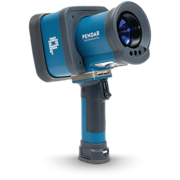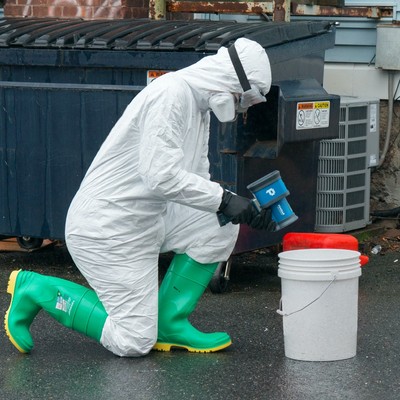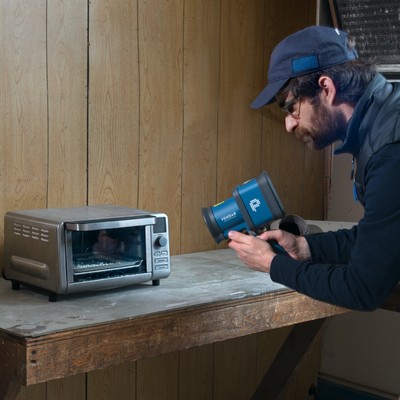Pendar X10
The revolutionary Pendar X10 Raman spectrometer for non-contact analysis of hazardous substances from Pendar technologies (USA), is now offered as an improved second generation. It is the result of many years of development by much of the original development team that many years ago built the first commercially successful handheld Raman spectrometer for hazardous substance detection - the Ahura FirstDefender. This has become the model for all current spectrometers and many of the solutions that these authors came up with (and patented) have not yet been surpassed.The "Ahura" spectrometers were a technological breakthrough at the product launch, and now the Pendar X10 spectrometers have also come up with new breakthrough technologies that allow the measurement of samples that were previously impossible to measure with Raman spectrometers (highly fluorescent samples, black samples, thermally unstable samples).
Video introducing the Pendar X10
The second generation of the Pendar X10 brings great technological improvements and solutions to the fundamental problems of all existing Raman spectrometers. The second generation spectrometer is smaller, lighter (1.5 kg), faster (typical analysis time in the units of seconds) and with the ability to measure from distances up to 200 centimeters. It uses a unique hardware technology to suppress the effects of fluorescence, eliminates the risk of ignition/initialization of energetically unstable materials, and allows interfacing with a range of EOD and CBRN robots. The spectrometer also uses an entirely new generation of chemometric algorithms that further improve identification reliability, especially for complex mixtures. Further information on the improvements brought by the second generation of the Pendar X10 can be found below.
The Pendar X10 spectrometer offers:
- Non-contact analysis with the ability to measure from up to 200 cm (from the second generation) from the sample, the ability to measure even small samples or, for example, to check the contents of drums and transport containers through filling holes.
- Ability to measure through several containers, to measure for example a sample placed in a fume hood through a plastic window, ability to measure through thick bottles. As a rule of thumb, if it is possible to see the sample inside the container, then it is possible to measure it. The technology eliminates the potential risk of damage to the packaging for highly toxic samples (a pinhole cannot be burned into the packaging).
- High measurement speed for common samples. Typical analysis time for ammonium nitrate placed in double packaging (plastic bag and polyethylene shipping container) is between 5 and 10 s (depending on the ambient light level at the measurement site).
- Ability to measure even highly fluorescent samples. The performance of the technology used in this respect significantly exceeds even the capabilities of all Raman spectrometers with a 1064 nm laser, without the negative effects associated with the use of a 1064 nm excitation laser (reduced sensitivity, higher noise in spectra, thermal destruction of samples). The spectrometer is also capable of measuring some extreme drug samples or specially labelled plastic explosives where all available Raman spectrometers have so far failed. In testing ecstasy tablets, the Pendar X10 spectrometer was able to identify MDMA in all tablets and in a very short time ( typically from 5 s to 30 s for extreme samples ).
- The ability to safely measure even thermally unstable samples that cannot be measured with conventional Raman spectrometers (black gunpowder, mercury fulminate or silver fulminate). In the link below you can see a demonstration of the identification of mercury fulminate.
https://vimeo.com/511420029/5b969a475b
- Ability to analyse inhomogeneous samples and spectrally problematic samples (e.g. street quality drugs). The spectrometer uses state-of-the-art chemometric algorithms in conjunction with higher spectral resolution. The quality of the spectral data is at the level of high quality laboratory systems. The Pendar X10 thus exhibits improved capabilities for fully automated analysis even for complicated samples. The spectrometer also allows rasterization of the sample surface, thus suppressing the effects of sample inhomogeneity. This problem is typical for some drug samples in tablet form, which exhibit high inhomogeneity in the distribution of the concentration of the active substance in the tablet volume. Standard Raman spectrometers give inconsistent results for repeated measurements in these samples (spot size is in the order of hundreds of microns and thus the effect of sample inhomogeneity is apparent).
- Safe measurements even without goggles, the laser used is class 3R!
- The Pendar X10 is ideal for cooperation with robotic devices (EOD and CBRN robots). The standard system allows samples to be analyzed from up to 2 m away. The instrument can be equipped with its own camera, which accurately displays the measured area, including visualization of the laser focusing on the sample surface. The spectrometer can communicate directly with the robot (using the robot's own communication channel) or be equipped with its own wireless communication module with a separate control tablet for the spectrometer operator. In this way, it is possible to provide interfacing even with older robot types.
Stand OFF Raman spectrometry (spectrometry for remote detection) presents a technological challenge, especially if it is to be applicable for measurements under normal light conditions. Highly efficient collection optics combined with a new generation of "super" detectors and powerful electronics must be used, since we have to measure very small Raman signals superimposed on an order of magnitude higher spectral background. The Pendar X10 spectrometer can now do all of this, and it does so at a weight of less than 1.5 kg including the battery. The instrument was first introduced outside the US at LaborExpo 2019 (where it won the Top Product award), was also awarded the R&D100 award, and won the most prestigious award in the photonics industry, the 2020 Prism Photonics Award in Security Technology, in a very competitive field.
Further information can be found in the information brochure below and on the manufacturer's website, including videos showing the Pendar X10 in action:
https://www.pendar.com/products/pendar-x10-handheld-raman/
The Pendar X10 instrument is available at RMI, s.r.o. If you would like a demonstration, please contact us.
-
 Brochure Pendar X10
size: 5.15 MB
Brochure Pendar X10
size: 5.15 MB
© 2025 RMI, s.r.o.
Created by eBRÁNA s.r.o. | Powered by WebArchitect | SEO a internetový marketing




![Unwrap / turn in [-]](/images/arr_down2.gif)
![Unwrap / turn in [+]](/images/arr_right.gif)